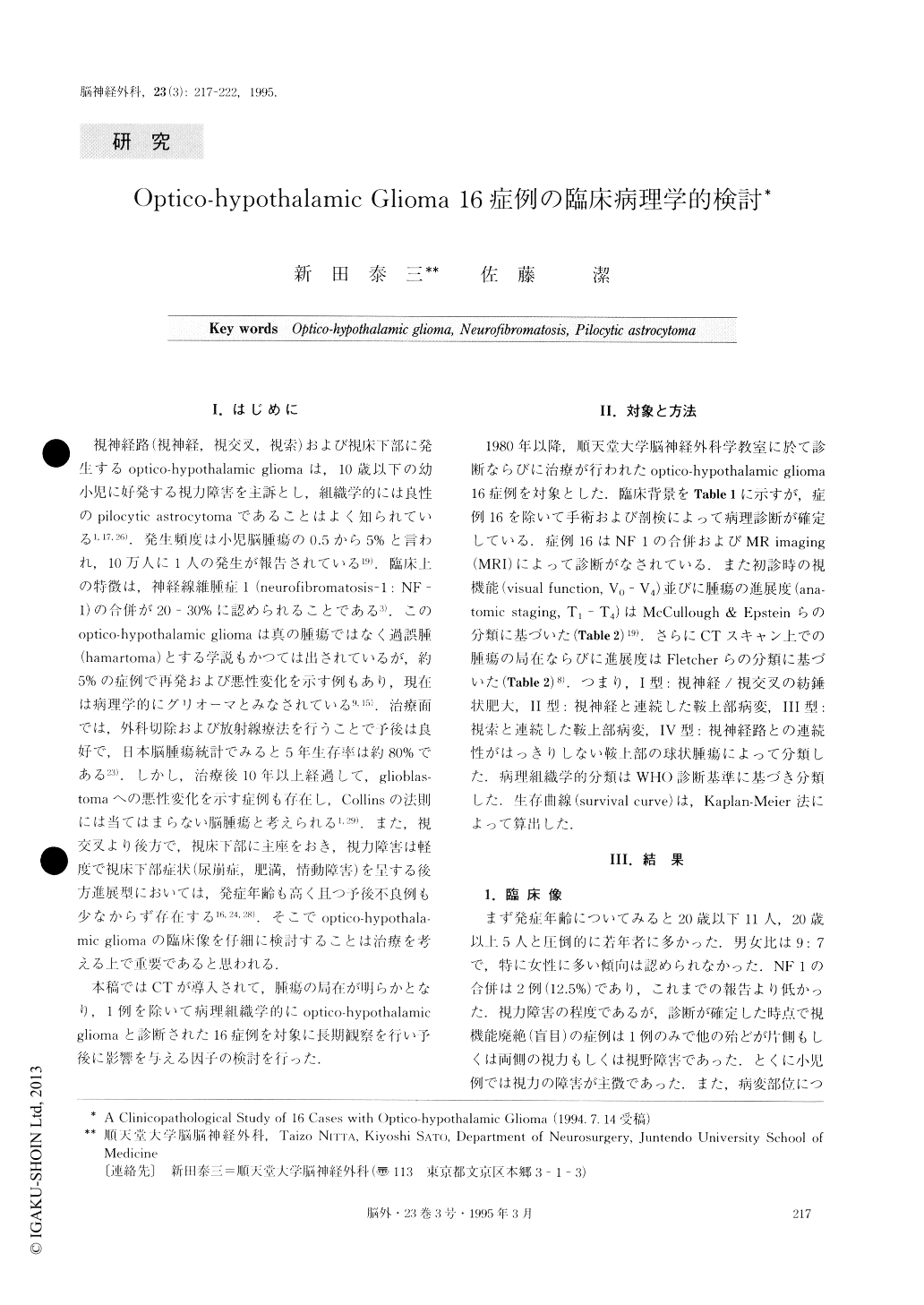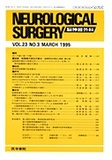Japanese
English
- 有料閲覧
- Abstract 文献概要
- 1ページ目 Look Inside
I.はじめに
視神経路(視神経,視交叉,視索)および視床下部に発生するoptico-hypothalamic gliomaは,10歳以下の幼小児に好発する視力障害を主訴とし,組織学的には良性のpilocytic astrocytomaであることはよく知られている1,17,26).発生頻度は小児脳腫瘍の0.5から5%と言われ,10万人に1人の発生が報告されている19).臨床上の特徴は,神経線維腫症1(neurofibromatosis−1:NF—1)の合併が20-30%に認められることである3).このoptico-hypothalamic gliomaは真の腫瘍ではなく過誤腫(hamartoma)とする学説もかつては出されているが,約5%の症例で再発および悪性変化を示す例もあり,現在は病理学的にグリオーマとみなされている9,15).治療面では,外科切除および放射線療法を行うことで予後は良好で,日本脳腫瘍統計でみると5年生存率は約80%であ23).しかし,治療後10年以上経過して,glioblas—tomaへの悪性変化を示す症例も存在し,Collinsの法則には当てはまらない脳腫瘍と考えられる1,29).また,視交叉より後方で,視床下部に主座をおき,視力障害は軽度で視床下部症状(尿崩症,肥満,情動障害)を呈する後方進展型においては,発症年齢も高く且つ予後不良例も少なからず存在する16,24,28).そこでoptico-hypothala-mic gliomaの臨床像を仔細に検討することは治療を考える上で重要であると思われる.本稿ではCTが導入されて,腫瘍の局在が明らかとなり,1例を除いて病理組織学的にoptico-hypothalamic gliomaと診断された16症例を対象に長期観察を行い予後に影響を与える因子の検討を行った.
Although gliomas of the optic nerve pathways, opti-co-hypothalamic gliomas, have been considered to be benign neoplasms, some recurrent, malignant gliomas especially at the optic chiasm and hypothalamus have also been reported. It is crucial to know the factors that influence the prognosis of these tumor entities. In order to address this question, we analyzed 16 cases of opti-co-hypothalamic gliomas treated in our institute with emphasis especially upon the age, location of tumor, histological subtype and treatment modality. Eleven pa-tients younger than 20 years and five older than 20 years were included in this study. In two patients the gliomas were accompanied by neurofibromatosis 1. The male to female ratio was 9: 7. Anatomical locations of the tumors were categorized from T1 to T4, and visual symptoms were Vo to V4. Patients with tumors located within the optic nerve, chiasm (T1-3) mainly presented visual symptoms, but those with hypothalamus (T4) showed neuroendocrine signs but not visual ones. Twelve out of 16 cases represented isodense mass le-sions on plain CT scans, which were homogenously en-hanced by contrast media. Among 15 cases verified pathologically, 10 cases were pilocytic astrocytomas, 4 were astrocytomas and one was anaplastic astrocytoma. The survival rate was measured by Kaplan-Meier method and overall 5-year survival rate was 70.5%. Pa-tients younger than 20 years could survive longer than those older than 20 years (87.5% and 40.0% respecti-vely). In regard to the tumor location, patients whose tumor was located mainly at the hypothalamus (T4) had a poor prognosis compared to those with a tumor at the optic nerve, chiasm (T1-3) (100%, 36.5%, 5-year survival rate respectively). Adjuvant radiotherapy(40-66Gy) was carried out on 9 patients, all patients with astrocytoma, anaplastic astrocytoma and some with in-completely resected pilocytic astrocytomas. We were unable to know the effectiveness of radiotheraphy against optico-hypothalamic glioma, since the number of cases was limited and they were not analyzed com-paratively. However, from cumulative evidence, it is strongly recommended that patients with optico-hypo-thalamic glioma should receive radiotherapy.

Copyright © 1995, Igaku-Shoin Ltd. All rights reserved.


